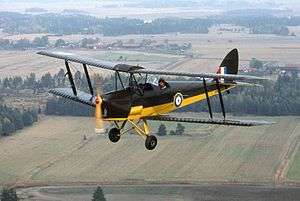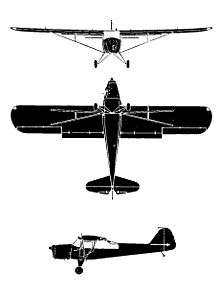No. 652 Squadron RAF
No. 652 Squadron RAF was a unit of the Royal Air Force during the Second World War and afterwards in Germany. Numbers 651 to 663 Squadrons of the RAF were Air Observation Post units working closely with Army units in artillery spotting and liaison. A further three of these squadrons, 664, 665 and 666, were AOP units of the Royal Canadian Air Force manned by Canadian and British personnel. Their duties and squadron numbers were transferred to the Army with the formation of the Army Air Corps on 1 September 1957.[1][4]
| No. 652 Squadron RAF | |
|---|---|
| Active | 1 May 1942 – 1 September 1957 |
| Country | |
| Branch | |
| Role | Air Observation Post Squadron |
| Motto(s) | Latin: Sive aere sive campo (Translation: "In the air and in the field")[1] |
| Insignia | |
| Squadron badge heraldry | In front of wings conjoined in base, a gun barrel fesswise[1] |
| Identification symbol | XM (Sep 1946 – 1951)[2][3] |
| Aircraft flown | |
| Reconnaissance | de Havilland Tiger Moth Taylorcraft Auster Auster AOP.6 |
History

Formation and World War II
No. 652 Squadron was formed at RAF Old Sarum, Wiltshire, on 1 May 1942 and went into action in Normandy on 7 June 1944 in support of the British Second Army and the Operation Overlord landings. Most of its pilots and observers came from the British Army, while maintenance was carried out by RAF personnel. The squadron moved with the Second Army through France, Belgium and the Netherlands into Germany.
Claim to fame
'C' Flight, No. 652 Squadron RAF has been credited with firing the last British shots of the war in Europe while directing artillery fire at the siege of Dunkirk on 7 May 1945, sharing in this action with No. 665 Squadron RCAF.
Post war service
After the German surrender it remained as part of the British Air Forces of Occupation, later of the 2nd Tactical Air Force.
No. 1902 Air Observation Post Flight was formed within 652 Squadron previously 'A' Flight also No. 1903 Air Observation Post Flight which was formed within 652 Squadron previously 'B' Flight[5] No. 1904 Air Observation Post Flight was formed within 652 Squadron previously 'C' Flight[5] No. 1905 Air Observation Post Flight was formed within 652 Squadron[5]
The unit was disbanded during September 1957, when it was merged into the Army Air Corps. It will be a Lynx Wildcat OCU Squadron in the future.[6]
The original squadron is represented today by 652 Squadron of 1 Regiment, Army Air Corps

Aircraft operated
| From | To | Aircraft | Variant |
|---|---|---|---|
| May 1942 | November 1942 | de Havilland Tiger Moth | Mk.II |
| August 1942 | March 1943 | Taylorcraft Plus | C.2 |
| October 1942 | March 1943 | Auster | Mk.I |
| March 1943 | March 1944 | Auster | Mk.III |
| February 1944 | August 1946 | Auster | Mk.IV |
| December 1944 | December 1953 | Auster | Mk.V |
| September 1946 | September 1957 | Auster | AOP.6 |
| January 1956 | September 1957 | Auster | AOP.9 |
Squadron bases
| From | To | Base | Remark |
|---|---|---|---|
| 1 May 1942 | 15 June 1942 | RAF Old Sarum, Wiltshire | |
| 15 June 1942 | 11 August 1942 | RAF Bottisham, Cambridgeshire | |
| 11 August 1942 | 31 December 1942 | RAF Westley, Suffolk | |
| 31 December 1942 | 20 February 1943 | RAF Dumfries, Dumfriesshire, Scotland | |
| 20 February 1943 | 28 March 1943 | RAF Sawbridgeworth, Hertfordshire | |
| 28 March 1943 | 2 July 1943 | RAF Methven, Perth and Kinross, Scotland | |
| 2 July 1943 | 7 November 1943 | RAF Ayr, Ayrshire, Scotland | |
| 7 November 1943 | 25 March 1944 | RAF Ipswich, Suffolk | |
| 25 March 1944 | 29 April 1944 | RAF Denham, Buckinghamshire | |
| 29 April 1944 | 7 June 1944 | RAF Cobham, Surrey | |
| 6 June 1944 | 7 June 1944 | Bény-sur-Mer, Calvados, France | Advance Party |
| 7 June 1944 | 8 July 1944 | Plumetot, Calvados, France | |
| 8 July 1944 | 1 August 1944 | Reviers, Calvados, France | |
| 1 August 1944 | 13 August 1944 | Blainville-sur-Orne, Calvados, France | |
| 13 August 1944 | 17 August 1944 | Grentheville, Calvados, France | |
| 17 August 1944 | 23 August 1944 | St-Pierre-sur-Dives, Calvados, France | |
| 23 August 1944 | 26 August 1944 | Lisieux, Calvados, France | |
| 26 August 1944 | 3 September 1944 | 49 13'N 00 29'E, Calvados, France | |
| 3 September 1944 | 4 September 1944 | Foucart, Seine-Maritime, France | |
| 4 September 1944 | 14 September 1944 | Angerville-l'Orcher, Seine-Maritime, France | |
| 14 September 1944 | 17 September 1944 | Héricourt-en-Caux, Seine-Maritime, France | |
| 17 September 1944 | 23 September 1944 | Parfondeval, Seine-Maritime, France | |
| 23 September 1944 | 27 September 1944 | Buken, Flemish Brabant, Belgium | |
| 27 September 1944 | 5 October 1944 | Zoersel, Antwerp, Belgium | |
| 5 October 1944 | 13 October 1944 | Het Geheul, Antwerp, Belgium | |
| 13 October 1944 | 19 October 1944 | Turnhout, Antwerp, Belgium | |
| 19 October 1944 | 23 October 1944 | 51 17'N 04 39'E, Antwerp, Belgium | |
| 23 October 1944 | 1 November 1944 | Maria ter Heide, Antwerp, Belgium | |
| 1 November 1944 | 4 November 1944 | Brasschaat, Antwerp, Belgium | |
| 4 November 1944 | 10 November 1944 | Roosendaal, Noord-Brabant, Netherlands | |
| 10 November 1944 | 31 December 1944 | Brasschaat, Antwerp, Belgium | |
| 31 December 1944 | 1 April 1945 | Tilburg, Noord-Brabant, Netherlands | |
| 1 April 1945 | 3 April 1945 | Kleve, Westphalia, Allied-occupied Germany | |
| 3 April 1945 | 30 April 1945 | Zutphen, Gelderland, Netherlands | |
| 1 May 1945 | 14 June 1945 | Rhede, Westphalia, Allied-occupied Germany | |
| 14 June 1945 | 16 November 1945 | Deilinghofen, Westphalia, Allied-occupied Germany | |
| 16 November 1945 | 29 April 1946 | RAF Hoya, Province of Hanover, British Zone of Occupation | |
| 29 April 1946 | 1 December 1947 | B.118/RAF Celle, Lower Saxony, British Zone of Occupation | Nos. 1902, 1903 & 1904 Flts. |
| 1 December 1947 | 1 May 1949 | B.156/RAF Luneburg, Lower Saxony, British Zone of Occupation | Nos. 1902, 1903, 1904 & 1905 Flts. |
| 1 May 1949 | 1 September 1957 | RAF Detmold, North Rhine-Westphalia, West Germany | Nos. 1901, 1904, 1905 & 1909 Flts. |
References
Notes
- Halley 1988, p. 445.
- Bowyer and Rawlings 1979, p. 114.
- Flintham and Thomas 2003, p. 160.
- Jefford 2001, pp. 102–105.
- Lake 1999, p. 99.
- http://www.janes.com/article/28343/british-army-helicopters-leave-germany
- Jefford 2001, p. 103.
Bibliography
- Flintham, Vic and Andrew Thomas. Combat Codes: A full explanation and listing of British, Commonwealth and Allied air force unit codes since 1938. Shrewsbury, Shropshire, UK: Airlife Publishing Ltd., 2003. ISBN 1-84037-281-8.
- Halley, James J. The Squadrons of the Royal Air Force & Commonwealth 1918–1988. Tonbridge, Kent, UK: Air Britain (Historians) Ltd., 1988. ISBN 0-85130-164-9.
- Jefford, C.G. RAF Squadrons, a Comprehensive record of the Movement and Equipment of all RAF Squadrons and their Antecedents since 1912. Shrewsbury, Shropshire, UK: Airlife Publishing Ltd., 1988 (second edition 2001). ISBN 1-85310-053-6.
- Lake, A (1999). Flying units of the RAF. Shrewsbury: Airlife. ISBN 1-84037-086-6.
External links
| Wikimedia Commons has media related to No. 652 Squadron RAF. |
